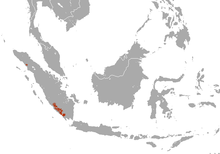Striped rabbit
| Striped rabbit | ||||||||||||
|---|---|---|---|---|---|---|---|---|---|---|---|---|
| Systematics | ||||||||||||
|
||||||||||||
| Scientific name | ||||||||||||
| Nesolagus | ||||||||||||
| Forsyth major , 1899 |
The nesolagus ( Nesolagus ) are a genus of the family of rabbits (Leporidae). They differ from all other rabbits by their striped coat pattern. Their basic color is gray on the upper side and white on the underside, several dark brown or black stripes run along the back, the flanks and the face. The ears are very short. With a head-torso length of 37 to 42 centimeters and a weight of around 1.5 kilograms, they are one of the smaller rabbit species. The genus includes two species, the Sumatran rabbit and the Annamite striped rabbit.
species
Sumatran rabbit
The Sumatran rabbit ( N. netscheri ) occurs exclusively in the west of the Indonesian island of Sumatra . Its habitat are mountain forests between 600 and 1600 meters high. Sumatran rabbits are extremely shy, nocturnal animals, during the day they retire in burrows or burrows from other animals. They are nourished by leaves and plant stems.
This animal is one of the rarest mammals at all. After several sightings between 1880 and 1916, it was not until 1972 that living specimens could be observed again. The main reason for the threat is the loss of habitat due to large-scale deforestation for the establishment of plantations. An estimate from 1996 is based on 250 living specimens, the IUCN classifies the species as "endangered" ( vulnerable ).
Annamite striped rabbit
The Annamite striped rabbit ( N. timminsi ) was not scientifically described until 2000. The first parts of this animal were found in a food market in Laos , and since then it has also been seen in Vietnam .
The Annamite striped rabbit lives in moist, evergreen forests on the seaward slopes of the Truong Son Mountains in areas where there is no or only a short dry period. Usually it is found at altitudes below 1000 meters. Since there are some sightings in heavily farmed areas (no clearcuts), habitat degradation is probably not the species’s greatest threat. Trap hunting is the main threat.
Systematics
|
Phylogenetic systematics of the rabbits according to Matthee et al. 2004
|
The striped rabbits are assigned to the hares (Leporidae) as an independent genus . The first scientific description was in 1899 by Charles Immanuel Forsyth Major .
On the basis of molecular biological data, Conrad A. Matthee et al. In 2004 a cladogram was developed which shows the phylogenetic relationships of the genera within the hares to one another. Accordingly, the striped rabbits are compared to a taxon consisting of the African bush rabbit ( Poelagus marjorita ) and the red rabbit ( Pronolagus ), which is also native to Africa, as a sister group . Together this group forms the sister group to all other hares genera.
supporting documents
- ↑ a b c Conrad A. Matthee, Bettine Jansen Van Vuuren, Diana Bell Terence J. Robinson: A Molecular Supermatrix of the Rabbits and Hares (Leporidae) Allows for the Identification of Five Intercontinental Exchanges During the Miocene. Systematic Biology 53 (3); Pp. 433-447. ( Abstract )
- ↑ a b Don E. Wilson & DeeAnn M. Reeder (eds.): Nesolagus ( Memento of the original from February 26, 2016 in the Internet Archive ) Info: The archive link was inserted automatically and has not yet been checked. Please check the original and archive link according to the instructions and then remove this notice. in Mammal Species of the World. A Taxonomic and Geographic Reference (3rd ed).
literature
- Ronald M. Nowak: Walker's Mammals of the World. Johns Hopkins University Press, Baltimore 1999, ISBN 0-8018-5789-9 .
Web links
- Nesolagus nets cheri in the endangered Red List species the IUCN 2009. Posted by: E. Meijaard, J. Sugardjito, 2008. Accessed November 7 in 2009.
- Nesolagus timminsi in the endangered Red List species the IUCN 2009. Posted by: A. Abramov u. a., 2008. Retrieved November 7, 2009.
